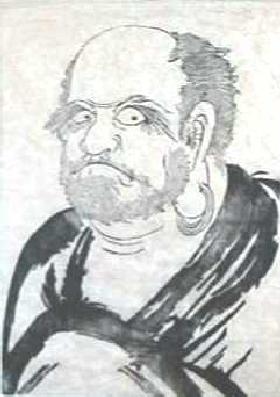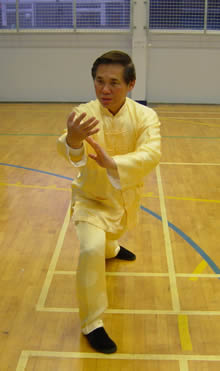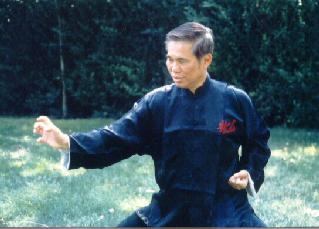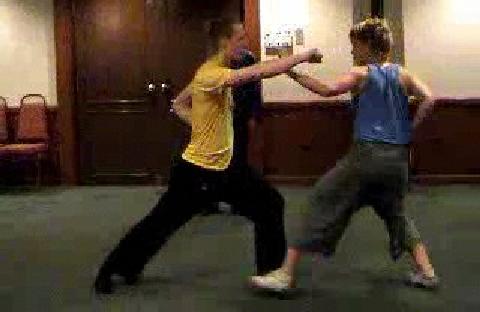October 2003 (Part 3)
SELECTION OF QUESTIONS AND ANSWERS

The great Bodhidharma, the First Patriarch of the Shaolin arts.
Question 1
I was thinking about a story you told me some tine ago about a Zen monk standing out in the snow who cut off his arm as a sacrifice to show his master how committed he was to his art.
— Douglas, Spain
Answer
This is the story about Bodhidharma and Hui Ke (pronounced like “Hui Ker”), the First and the Second Patriarch of Zen respectively. It was snowing and Hui Ke had been waiting in the snow for many hours for Bodhidharma to come out of his meditation.
When Bodhidharma eventually emerged, Hui Ke, who had earlier learned chi kung and meditation from the master, begged for further teaching. When Bodhidharma rejected him, he pleaded with the master and asked when he could receive further teaching, Bodhidharma said he would teach only when the snow turned red.
Using his internal force, Hui Ke severed his left arm. Blood gushed out turning the snow red. “What would you like to learn?” Bodhidharma asked. “My mind is troubling me,” Wei Ke replied. “Bring out your mind and I'll calm it”.
Hui Ke searched for his mind, but didn't find any. “Strange, I cannot find my mind. I have no mind!” “I've calmed your mind” Bodhidharma said. At that instant Hui Ke was enlightened.
Question 2
I don't know why the story popped into my mind again, but it occurred to me that if that monk had achieved a breakthrough of “no mind”, then he would have realized that his body was only a reflection of his individual mind. When the mind disappears, so should the body (like a mirror image disappearing when the mirror is taken away). So what did he cut off? Where was the sacrifice? Or by cutting off this own arm, was he merely acknowledging something his teacher already knew?
Answer
Before Hui Ke severed his arm, he still had mind. His break-through came about only when he searched for his mind, acting on his teacher's instruction to bring out his mind for the master to calm. Hence, at the time he severed his arm, Hui Ke did not experience that his body was a reflection of his individual mind, though he might, or might not, have known this theoretically. So he cut off his arm, which was real to him relative to his conditions at that time. The sacrifice was severing his arm to let blood redden the snow to fulfill the condition his master had set for further teaching.
Your question whether Hui Ke was acknowledging something Bodhidharma already knew, perhaps as a dramatic demonstration of his understanding of Zen, is interesting. Bodhidharma, as a great Zen master, knew that from the cosmic perspective Hui Ke's arm or anything else is an illusion. The arm or anything else was real to Hui Ke or anybody else only relative to a set of conditions, like the way the eyes and other sense organs interpreted energy.
When this set of conditions changed or disappeared, as in a moment of awakening or enlightenment, the arm would not be there anymore. Hui Ke might or might not know this cosmic fact. I believe he knew, but before his enlightenment this understanding was intellectual, not experiential. Notwithstanding this, I believe Hui Ke's severing of his arm was not meant as a demonstration of his knowing a cosmic truth; it was an immediate and direct response of a good student to his teacher's condition for further teaching.
This story is a good illustration of heart to heart transmission, and my explanation here will be very useful to perceptive students, especially those in Shaolin Wahnam. Bodhidharma was an excellent teacher, and Hui Ke an excellent student. Bodhidharma, after having trained Hui Ke in the preliminaries, grasped just the right moment to ask Hui Ke bring out his mind. Had Hui Ke attempted to be intellectual, as many modern Western students do, and asked his teacher or himself such questions like “What is mind?” or “Why must I bring out my mind?”, he would have missed the golden opportunity. Instead, as an excellent student he was, he just did what his teacher said, and attained enlightenment.
Such occasions happened quite frequently in our Shaolin Wahnam training, albeit at a much lower level. At the right moment in chi kung training, for example, I might ask a student to relax. A foolish student might retort, “But I am relaxed” or ask “How do you relax?”, and missed the opportunity. A good student would just do what I said and attained an energy break-through. In Standing Meditation I might ask a student to just let go. A foolish student might ask me or himelf how to let go, and missed the opportunity. A good student would just do what I said and attained a sense of immense peace and spirtual expansion.

"Grasping Sparrow's Tail" is an effective method to develop internal force if it is performed as a chi kung exercise.
Question 3
When, if ever, is it appropriate for a disciple to ask his teacher to teach him an advanced art?
Answer
This depends on numerous variables, such as the character of the teacher, the relationship between the teacher and the disciple, and the understanding and developmental stage of the disciple.
For some teachers, a disciple has no opportunity to ask to be taught an advanced art. Doing so would result in the disciple being told to pack his things to go home. Such teachers are usually very stict and demanded very high standards from their disciples. Uncle Righteousness was an example of such a teacher.
On the other hand, some modern teachers would teach a student any advanced arts he wants as long as he pays the fees demanded. Such advanced arts usually turn out to be only external forms without the internal essence. For example, the student may learn the correct techniques of an advanced art like the “Small Universe”, but may not have any energy flow at all.
The teacher-disciple relationship is a great influential variable. For example, I was extremely lucky when I learned Wing Choon Kungfu from Sifu Choe Hoong Choy, who treated me more like an equal than as a student. I could choose whatever advanced arts I liked, such as “Flower Set” and “Six-and-a-Half-Point Staff”, and Sifu Choe would “pass them on” to me in a matter of days! His normal students did not have this luxury. They would take months if not years to learn an advanced set, and only when he chose to teach them, not when they requested it.
Question 4
I met a Taijiquan master who had a lot of internal force. He only practices his forms and does not practice zhan zhuang. Can one develop internal force by practicing forms only without zhan zhuang?
Answer
Yes, one can develop internal force by practicing forms only, without practicing zhan zhuang, or stance training. But the practitioner has to work on his energy while performing the forms. If he works on his physical forms only, like what many external martial artists and body builders do, he may develop muscular strength but not internal force.
We do this in our chi kung exercises, like in “Pushing Mountains”. By practicing “Pushing Mountains”, and without performing zhan zhuang, one can develop quite a lot of internal force. But if he performs “Pushing Mountains” as a physical exercise, as many people do although they mistakenly think they are performing chi kung, he will not develop internal force.
The crucial difference between physical exercise and chi kung is that the former works on the physical body whereas the latter works on energy. Failing to understand this difference leads many people think they can easily learn chi kung from books or videos. It is also a main reason why so many people who say they practice chi kung, do not get the benefits of chi kung even though they may have practiced for a long time.
The same principles apply in Taijiquan. Any patterns in Taijiquan when practiced as chi kung will develop internal force. Some Taijiquan patterns are more suitable than others for force development. Two excellent examples are “Lifting Water” and “Grasping Sparrow's Tail”.
You may perform only one pattern, such as “Lifting Water”, over and over again many times. Or you may perform the whole Taijiquan set. Either way can develop a lot of internal force if you practice daily for a reasonable period of time, like a year. I would like to repeat: one has to perform the individual pattern or the whole set as chi kung. If he perform them as physical exercise he will not develop any internal force even if he has practiced for ten years. If he ever has some internal force, it is an incidental bonus.
Question 5
If it is possible to develop internal force from form training, what is the difference between this internal force and that from zhan zhuang?
Answer
The internal force developed from form training — such as from “Lifting Water” and “Grasping Sparrow's Tail” in Taijiquan, and “Pushing Mountains” and “One Finger Shooting Zen” in Shaolin Kungfu, or from the whole set of Taijiquan or from the whole set of Shaolin “Dragon Strength” — is fluid, whereas that developed from zhang zhuang or stance training — such as from “Three-Circle Stance” in Taijiquan, and “Golden Bridge” in Shaolin Kungfu — is solid.
As an anology, the internal force from from training is like flowing water, whereas that from zhan zhuang is like solid ice. This analogy is not exact, but it gives a rough idea of the difference.
If all other things were equal, the internal force developed from zhan zhaung is more powerful than the internal force developed from form training. That was why zhan zhaung was the single most widely used method by past kungfu masters, irrespective of their kungfu styles, to develop internal force.
However, zhan zhuang must be practiced correctly or else it would result in adverse effects. Paradoxically, because it is simple — there is only one posture to practice — it is easy to make mistakes. If the practitioner makes just one mistake in his posture, he will be 100% wrong in his training.
Form training to develop internal force is comparatively safer. Because there are many movements in an individual form to be repeated, or many different forms in a set to be performed, even if the practitioner makes a few mistakes, the benefits from the correct movements can compensate for the adverse effects from the wrong movements. Moreover, chi is generally flowing in form training — in contrast with chi being consolidated in zhan zhaung — and this flowing chi can flush away the adverse effects as they are made.

Developing internal force is an essential part of Sifu Wong's Intensive Shaolin Kungfu Course. Here Sifu Wong demonstrates the training of the Tiger-Claw.
Question 6
Is the Drawing the Moon chi kung which you describe in “The Art of Chi Kung” OK for men to practice as well as women? I am slightly overweight and although I am pursuing an exercise program, would like to harmonize it with chi kung practice.
— Ian, England
Answer
Yes, “Drawing the Moon” is suitable for both men and women to reduce excess mass at the stomach region. It is very effective. Practice it twice a day, gradually increasing the number of times in drawing the moon. You may have to change all your trousers in six months.
Question 7
I am already doing “Lifting the Sky” and “Carrying the Moon” daily but I wouldn't add the second qigong of “Separating Water for a lovely bust”, as it seems inappropriate for men.
Answer
“Separating Water” is also suitable for men. While it enables women to have lovely busts, it enables men to have robust chests. It is also excellent for overcoming depression. “Lifting the Sky”, “Carrying the Moon” and “Separating Water” are a good combination for daily practice. (Those who have learnt chi kung from me personally need to practice only one exercise, or one set of self-manifested chi movement exercise, per session.)

Course participants should familiarize themselves with the Shaolin 16 combat sequences before attending the Intensive Shaolin Kungfu Course
Question 8
Do all Shaolin kungfu schools worldwide teach the same basic forms or does each school perform differently in their stances and patterns and movements?
— Chris, Australia
Answer
Although there are variations, all Shaolin kungfu schools worldwide teach the same basic stances and movements.
The basic stances are Horse-Riding, Bow-Arrow, False Leg, Single Leg, and Unicorn Step. In many schools today, the Bow-Arrow Stance is performed with the two feet slight away from a central line, leaving the groin exposed, whereas in our Shaolin Wahnam School it is performed with the two feet along a central line covering the groin.
The basic movements are the same. For example, when a right level punch is executed from a left Bow-Arrow Stance, the waist rotates, the body is upright, and both feet are firmly on the ground. If the body and right shoulder are thrown forward, and the right heel is raised, it is not a typical Shaolin movement. If this is performed in some Shaolin schools, as it sometimes happens, this Shaolin movement has been adulterated. Possibly some teachers along the lineage imitated Boxing or Karate punches.
The main patterns are the same, but because there are many patterns in Shaolin Kungfu, the actual patterns taught in different schools may not be the same. In other words, patterns A, B, C, D and E are the same in all Shaolin kungfu schools, but one school may teach patterns A, B and C, another may teach A, C and D, and the third may teach C, D and E.
Numerous patterns are linked together to form a sequence, and numerous sequences are linked together to form a set. Some sets, however, are composed not of sequences but of individual patterns. These patterns, sequences and sets, which themselves involve stances and movements, are collectively known as form.
Form is one aspect of kungfu. The other aspects are force, application and philosophy.
All Shaolin schools teach the same form, although the actual patterns, sequences and sets may be different. If someone performs a series of martial art movements, by looking at his form we can tell whether his is Shaolin Kungfu form. For example, if he bounces about, or kicks wildly, then his is not Shaolin Kungfu.
However, the term “form” is sometimes used to refer to a kungfu set. In this case, different schools teach different forms, in the sense of different kungfu sets.
Question 9
I hope to attend your Shaolin course in the future and hope that what I learn won't be a lot different to what you teach. I understand you require that we are well versed in the basics before considering to attend your Shaolin course. Would it be best to learn basic forms from any Shaolin kungfu teacher or is it possible to learn from your books?
Answer
What you learn, even from my books, will be very different from what I teach in my Intensive Shaolin Kungfu Course, otherwise it would not be justified for you to pay US$1500 to attend. What you learn from other Shaolin schools or from my books is form. What you will learn in my course are force and application. This is a crucial difference many people do not realize.
I also explain force and application, besides philosophy, in my books. But these aspects of kungfu should be learnt personally from a master. Many other Shaolin schools teach force, but mainly external force like hitting sandbags and striking poles, which we affectionately call “water-buffalo” training. Very few Shaolin schools today teach internal force, which we consider superior training. In other schools, irrespective of whether it is external or internal, it takes a long time — many months or years — to experience force. In my Intensive Shaolin Kungfu Course, students develop and experience internal force the very first day!
Many kungfu schools today teach only form, and nothing else. Combat application is found in many other schools, but it is combat application of random techniques and not combat application of Shaolin Kungfu. Even such combat application is not systematically taught. Students just engage in free sparring, and generally hurt themselves. A practitioner may have learned Shaolin Kungfu for 20 years, yet cannot apply typical Shaolin techniques for combat (though he may be a good fighter using other techniques). In my course, a student can apply typical Shaolin techniques for combat after 5 days!
Yet, what you will learn is not just combat application, but application of Shaolin Kungfu to enrich your daily life. If you spend an hour a day training to be effective in fighting, which seldom happens in real life, it is a very poor use of time. If the training harms you physically and psychologically, as it happens in some martial arts, it becomes silly.
The internal force you will develop in the course, which involves training of energy and mind, will enable you to do better whatever you do. The skills and techniques you will apply in systematic sparring — such as right timing, correct spacing, quick decision and fluid movement — will enable you to derive more rewards from your daily work and play. The combat principles you will learn — such as safety first, four modes of preparation, and three arrivals — will give you a clear advantage over others in business and social life.
One invaluable benefit of the course is developing a positive, joyful philosophy towards life. This philosophy is noticeable if you examine the discussions by our Shaolin Wahnam members in our Shaolin Wahnam Discussion Forum, or if you compare the discussions here with those of other forums on the internet. You will learn from direct experience in the course that determined effort is required to achieve any worthwhile goals, and that selecting the best available methods and training systematically will enable us to attain our aims more efficiently.
Hence, while others who have no idea what one can achieve in my courses, complain that my fees are exorbitant, many who have learnt from me, have expressed that they could never thank me enough.
To attend my Intensive Shaolin Kungfu Course, you should have at least the basic stances and movements of Shaolin Kungfu, or of some relevant martial arts. The best, of course, is to learn from a Shaolin Wahnam kungfu instructor first. If this is not possible, it is generally better to learn from any other kungfu teacher, even if he teaches only kungfu gymnastics, than learning from my books. But a few have found learning from my books a very effective preparation for my course.
